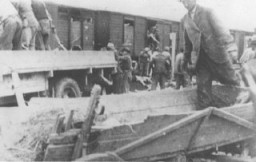You searched for: sem推廣專員【TG飞机:@bapingseo】谷歌推广北京代理【TG电报:@bapingseo】斯里兰卡google竞价【Telegram:@bapingseo】30个娱乐平台网站mg游戏中心官方?20220706qM7uz6.html
<< Previous | Displaying results 76-100 of 396 for "sem推廣專員【TG飞机:@bapingseo】谷歌推广北京代理【TG电报:@bapingseo】斯里兰卡google竞价【Telegram:@bapingseo】30个娱乐平台网站mg游戏中心官方?20220706qM7uz6.html" | Next >>
-
World War II Dates and Timeline
ArticleWorld War II was the largest and most destructive conflict in history. Learn about key WWII dates in this timeline of events, including when WW2 started and ended.

-
Law on the Head of State of the German Reich
ArticleThe Law on the Head of State of the German Reich was the last step in destroying democracy in interwar Germany and making Adolf Hitler a dictator. Learn more.
-
Adolf Eichmann: Key Dates
ArticleAdolf Eichmann was a key figure in implementing the “Final Solution,” the Nazi plan to kill Europe's Jews. Learn more through key dates and events.

-
Nazi Rule
ArticleAfter they rose to power in 1933, Hitler and the Nazis eliminated democratic freedoms and took control of all aspects of public life in Germany. Learn more.

-
1938: Key Dates
ArticleExplore a timeline of key events in the history of Nazi Germany during 1938.

-
Althammer
ArticleThe Germans established the Althammer camp in September 1944. It was a subcamp of Auschwitz. Read more about the camp's history and conditions there.
-
The 84th Infantry Division during World War II
ArticleThe 84th Infantry Division participated in major WWII campaigns and is recognized for liberating two Neuengamme subcamps, Hannover-Ahlem and Salzwedel, in 1945.
-
Haviva Reik
Media EssayHaviva Reik was one of 32 Jewish parachutists from Palestine who volunteered to join the British army and infiltrate German-occupied Europe. Reik was sent to Slovakia on a mission to aid Jews during the Slovak nationa...
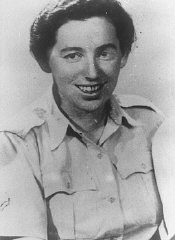
-
Lodz ghetto
FilmThe German army occupied Lodz, Poland, in September 1939. From early February 1940, Jews in Lodz were forced to move to a designated ghetto area, which was sealed on April 30, 1940. This German footage illustrates conditions during winter in the Lodz ghetto. Winter in the ghettos aggravated existing hardships, depleting already sparse supplies of food and fuel.
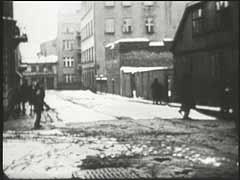
-
Conditions in the Warsaw ghetto
FilmThe Nazis sealed the Warsaw ghetto in mid-November 1940. German-induced overcrowding and food shortages led to an extremely high mortality rate in the ghetto. Almost 30 percent of the population of Warsaw was packed into 2.4 percent of the city's area. The Germans set a food ration for Jews at just 181 calories a day. By August 1941, more than 5,000 people a month succumbed to starvation and disease.
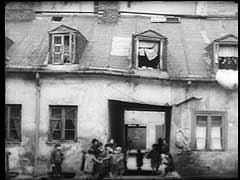
-
Conditions in the Warsaw ghetto
FilmThe Nazis sealed the Warsaw ghetto in mid-November 1940. German-induced overcrowding and food shortages led to an extremely high mortality rate in the ghetto. Almost 30 percent of the population of Warsaw was packed into 2.4 percent of the city's area. The Germans set a food ration for Jews at just 181 calories a day. By August 1941, more than 5,000 people a month succumbed to starvation and disease.
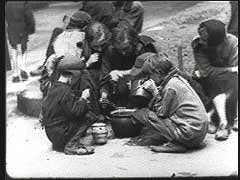
-
Lion Feuchtwanger in New York
PhotoAuthor Lion Feuchtwanger in New York, November 17, 1932. Feuchtwanger's 1930 novel Erfolg (Success) provided a thinly veiled criticism of the Beer Hall Putsch and Hitler's rise to leadership in the Nazi Party. He was targeted by the Nazis. After the Nazi takeover on January 30, 1933, his house in Berlin was illegally searched and his library was plundered during his lecture tour in the United States.
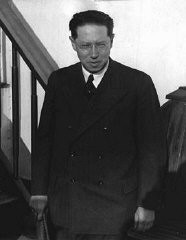
-
Ernest Hemingway
PhotoPortrait of Ernest Hemingway by Helen Pierce Breaker. Paris, France, ca. 1928. In 1933, Nazi students at more than 30 German universities pillaged libraries in search of books they considered to be "un-German." Among the literary and political writings they threw into the flames were the works of Ernest Hemingway.
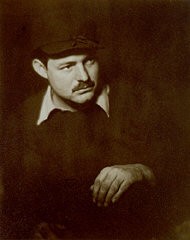
-
Cover of A Farewell to Arms
PhotoCover of Ernest Hemingway's A Farewell to Arms. (1929 cover. Princeton University Library.) In 1933, Nazi students at more than 30 German universities pillaged libraries in search of books they considered to be "un-German." Among the literary and political writings they threw into the flames during the book burning were the works of Ernest Hemingway.
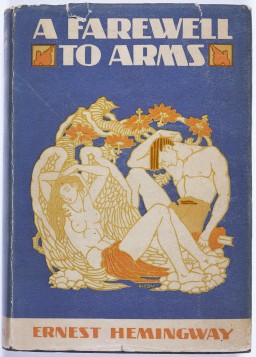
-
Hemingway on a safari
PhotoAmerican novelist Ernest Hemingway on safari, ca. 1933. In 1933, Nazi students at more than 30 German universities pillaged libraries in search of books they considered to be "un-German." Among the literary and political writings they threw into the flames were the works of Ernest Hemingway.

-
Ernest Hemingway
PhotoAuthor Ernest Hemingway aboard the boat Pilar, ca. 1950. In 1933, Nazi students at more than 30 German universities pillaged libraries in search of books they considered to be "un-German." Among the literary and political writings they threw into the flames were the works of Ernest Hemingway.
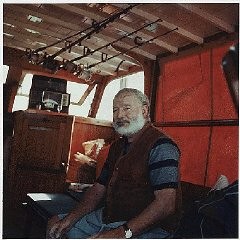
-
Henrietta and Herman Goslinski
PhotoIn 1942, Henrietta and Herman Goslinski went into hiding to avoid deportation from the Netherlands. Their rescuer could not, however, also take their infant daughter Berty. The Dutch resistance moved Berty frequently; she was eventually moved more than 30 times. During the two-and-a-half years apart, the parents saw Berty only once and received this single photograph of her taken while she was in hiding.

-
US troops view corpses of prisoners massacred by SS guards
PhotoUS troops view corpses of prisoners massacred by SS guards in a wooded area near the Kaufering IV subsidiary camp of the Dachau concentration camp. Landsberg- Kaufering, Germany, April 30, 1945.
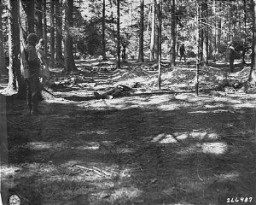
-
Torchlight parade in honor of Hitler's appointment as chancellor
PhotoAdolf Hitler, Wilhelm Frick, and Hermann Göring wave to a torchlight parade in honor of Hitler's appointment as chancellor. Behind Göring stands Rudolf Hess. Berlin, Germany, January 30, 1933.

-
Babi Yar massacre
PhotoOn September 29-30, 1941, SS and German police units and their auxiliaries, under guidance of members of Einsatzgruppe C, murdered the Jewish population of Kiev at Babi Yar, a ravine northwest of the city. This photograph shows groups of Jews being forced to hand over their possessions and undress before being shot in the ravine.
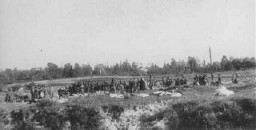
-
Soviet soldiers guard the entrance to Hitler's underground bunker
PhotoSoviet soldiers guard the entrance to Adolf Hitler's underground bunker. Upon the advance of Soviet forces through the streets of Berlin, Hitler committed suicide here on April 30, 1945, rather than face capture. Berlin, Germany, 1945.
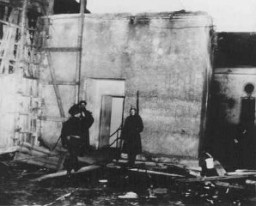
-
Boxcars containing bodies of victims outside the Dachau camp
PhotoUS soldiers discovered these boxcars loaded with dead prisoners outside the Dachau camp. Here, they force German boys—believed to be members of the Hitler Youth (Hitlerjugend; HJ)—to view the atrocity. Dachau, Germany, April 30, 1945.
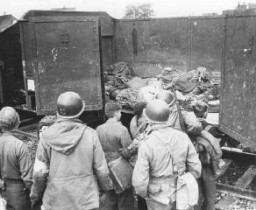
-
Cover of a work by Sigmund Freud
PhotoSigmund Freud: Massenpsychologie und Ich-Analyse, cover. In 1933, Nazi students at more than 30 German universities pillaged libraries in search of books they considered to be "un-German." Among the literary and political writings they threw into the flames were all the works of Sigmund Freud that were published by 1933.
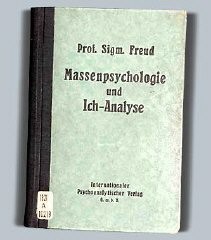
-
Symbolic groundbreaking ceremony
PhotoMembers of the United States Holocaust Memorial Council pose with two milkcans containing a Scroll of Remembrance signed by Holocaust survivors at a symbolic groundbreaking ceremony for the United States Holocaust Memorial Museum. Benjamin Meed is second from the left. Washington, DC, April 30, 1984. During groundbreaking ceremonies in April 1985, the containers were buried on the site of the Museum.
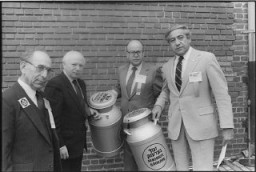
-
Aftermath of pogrom in Iasi
PhotoRoma (Gypsies) remove bodies from the Iasi-Calarasi death train during its stop in Tirgu-Frumos. Two trains left Iasi on June 30, 1941, bearing survivors of the pogrom that took place in Iasi on June 28-29. Hundreds of Jews died on the transports aboard crowded, unventilated freight cars in the heat of summer. Romania, July 1, 1941.
